Analysis of Business Environment: Types, Functions, and Scope
VerifiedAdded on 2023/01/12
|17
|4783
|95
Report
AI Summary
This report offers a comprehensive analysis of the business environment, encompassing various organizational structures (private, public, and voluntary), their scopes, and functions. It delves into the characteristics of different organizational types, including sole traders, private limited, public limited, and partnerships, highlighting their roles and objectives. The report explores the scope and size of organizations, using Tesco as a case study to illustrate how mission, vision, objectives, and structure contribute to business success. It further examines the co-relation between firm objectives and their scope and size, and differentiates between international, global, and transnational organizational structures. The report also describes various business functions, such as Human Resources and Marketing, and their relevance to a firm's mission and objectives. Finally, it compares micro, small, medium, and large enterprises, and determines the strengths and weaknesses of a business in relation to the macro environment, explaining how these factors interrelate. Overall, the report provides a detailed understanding of the business environment and its various components.
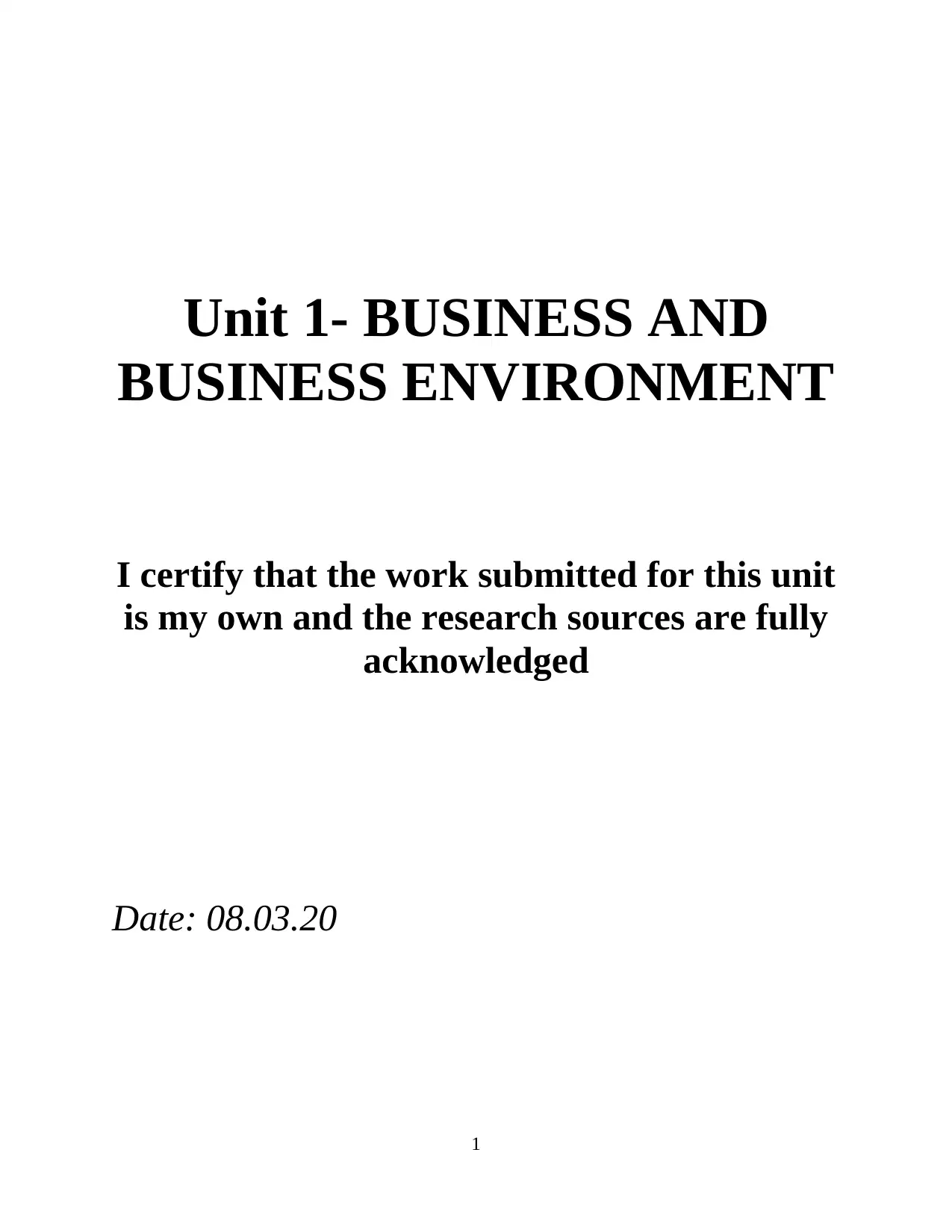
Unit 1- BUSINESS AND
BUSINESS ENVIRONMENT
I certify that the work submitted for this unit
is my own and the research sources are fully
acknowledged
Date: 08.03.20
1
BUSINESS ENVIRONMENT
I certify that the work submitted for this unit
is my own and the research sources are fully
acknowledged
Date: 08.03.20
1
Paraphrase This Document
Need a fresh take? Get an instant paraphrase of this document with our AI Paraphraser

Table of Contents
INTRODUCTION...........................................................................................................................3
Task 1...............................................................................................................................................3
Briefly explain types of organisational structure-..................................................................3
Elaborate scope &size of organisations..................................................................................5
TASK 2............................................................................................................................................8
Describe various types of functions in relevance with mission and objectives of firm.........8
TASK 3..........................................................................................................................................10
Comparison between micro, small, medium size and large enterprises...............................10
TASK 4..........................................................................................................................................13
Determine strength and weakness of business in relation with macro environment...........13
Explain how strength and weakness interrelate with external macro factors each other....15
CONCLUSION..............................................................................................................................16
REFERENCES..............................................................................................................................17
2
INTRODUCTION...........................................................................................................................3
Task 1...............................................................................................................................................3
Briefly explain types of organisational structure-..................................................................3
Elaborate scope &size of organisations..................................................................................5
TASK 2............................................................................................................................................8
Describe various types of functions in relevance with mission and objectives of firm.........8
TASK 3..........................................................................................................................................10
Comparison between micro, small, medium size and large enterprises...............................10
TASK 4..........................................................................................................................................13
Determine strength and weakness of business in relation with macro environment...........13
Explain how strength and weakness interrelate with external macro factors each other....15
CONCLUSION..............................................................................................................................16
REFERENCES..............................................................................................................................17
2
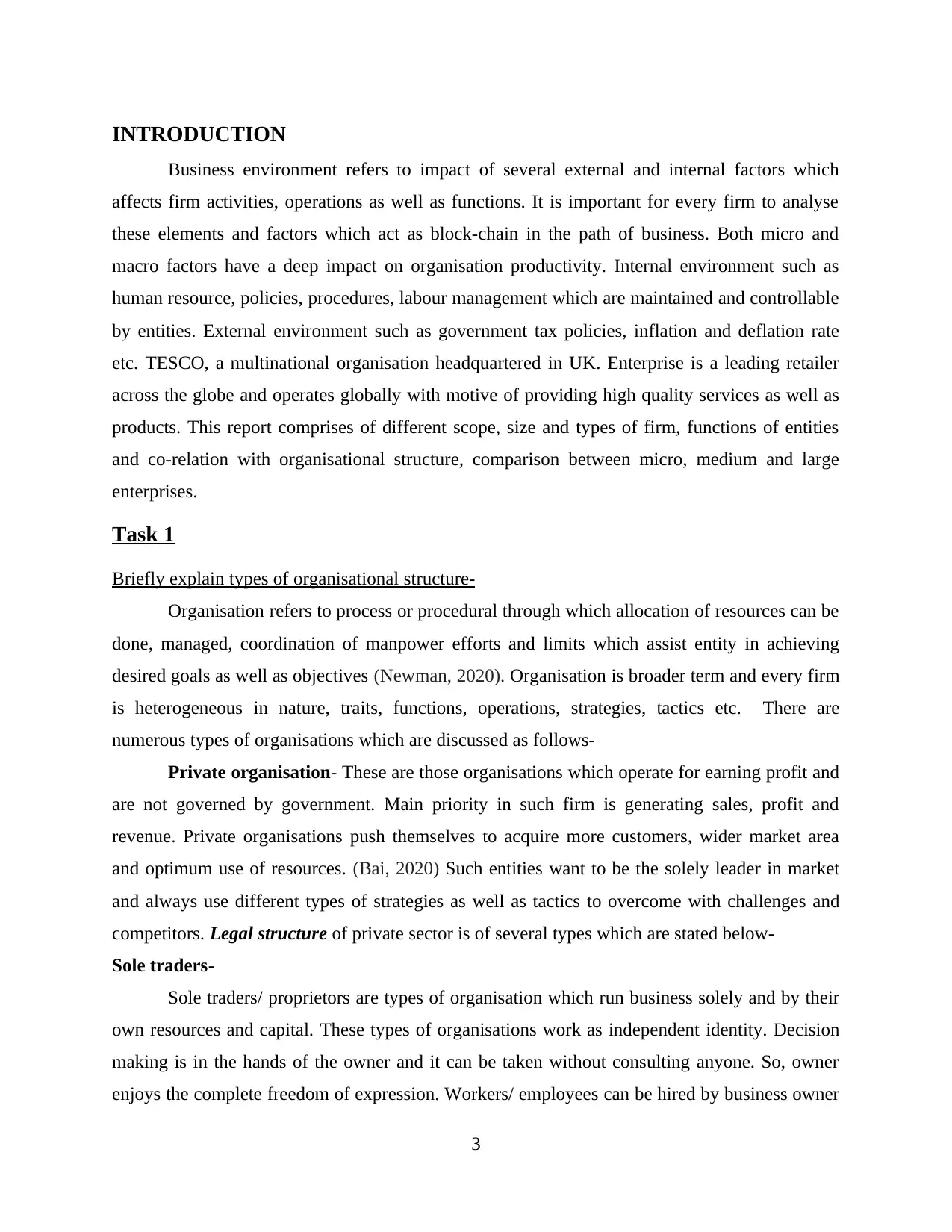
INTRODUCTION
Business environment refers to impact of several external and internal factors which
affects firm activities, operations as well as functions. It is important for every firm to analyse
these elements and factors which act as block-chain in the path of business. Both micro and
macro factors have a deep impact on organisation productivity. Internal environment such as
human resource, policies, procedures, labour management which are maintained and controllable
by entities. External environment such as government tax policies, inflation and deflation rate
etc. TESCO, a multinational organisation headquartered in UK. Enterprise is a leading retailer
across the globe and operates globally with motive of providing high quality services as well as
products. This report comprises of different scope, size and types of firm, functions of entities
and co-relation with organisational structure, comparison between micro, medium and large
enterprises.
Task 1
Briefly explain types of organisational structure-
Organisation refers to process or procedural through which allocation of resources can be
done, managed, coordination of manpower efforts and limits which assist entity in achieving
desired goals as well as objectives (Newman, 2020). Organisation is broader term and every firm
is heterogeneous in nature, traits, functions, operations, strategies, tactics etc. There are
numerous types of organisations which are discussed as follows-
Private organisation- These are those organisations which operate for earning profit and
are not governed by government. Main priority in such firm is generating sales, profit and
revenue. Private organisations push themselves to acquire more customers, wider market area
and optimum use of resources. (Bai, 2020) Such entities want to be the solely leader in market
and always use different types of strategies as well as tactics to overcome with challenges and
competitors. Legal structure of private sector is of several types which are stated below-
Sole traders-
Sole traders/ proprietors are types of organisation which run business solely and by their
own resources and capital. These types of organisations work as independent identity. Decision
making is in the hands of the owner and it can be taken without consulting anyone. So, owner
enjoys the complete freedom of expression. Workers/ employees can be hired by business owner
3
Business environment refers to impact of several external and internal factors which
affects firm activities, operations as well as functions. It is important for every firm to analyse
these elements and factors which act as block-chain in the path of business. Both micro and
macro factors have a deep impact on organisation productivity. Internal environment such as
human resource, policies, procedures, labour management which are maintained and controllable
by entities. External environment such as government tax policies, inflation and deflation rate
etc. TESCO, a multinational organisation headquartered in UK. Enterprise is a leading retailer
across the globe and operates globally with motive of providing high quality services as well as
products. This report comprises of different scope, size and types of firm, functions of entities
and co-relation with organisational structure, comparison between micro, medium and large
enterprises.
Task 1
Briefly explain types of organisational structure-
Organisation refers to process or procedural through which allocation of resources can be
done, managed, coordination of manpower efforts and limits which assist entity in achieving
desired goals as well as objectives (Newman, 2020). Organisation is broader term and every firm
is heterogeneous in nature, traits, functions, operations, strategies, tactics etc. There are
numerous types of organisations which are discussed as follows-
Private organisation- These are those organisations which operate for earning profit and
are not governed by government. Main priority in such firm is generating sales, profit and
revenue. Private organisations push themselves to acquire more customers, wider market area
and optimum use of resources. (Bai, 2020) Such entities want to be the solely leader in market
and always use different types of strategies as well as tactics to overcome with challenges and
competitors. Legal structure of private sector is of several types which are stated below-
Sole traders-
Sole traders/ proprietors are types of organisation which run business solely and by their
own resources and capital. These types of organisations work as independent identity. Decision
making is in the hands of the owner and it can be taken without consulting anyone. So, owner
enjoys the complete freedom of expression. Workers/ employees can be hired by business owner
3
⊘ This is a preview!⊘
Do you want full access?
Subscribe today to unlock all pages.

Trusted by 1+ million students worldwide
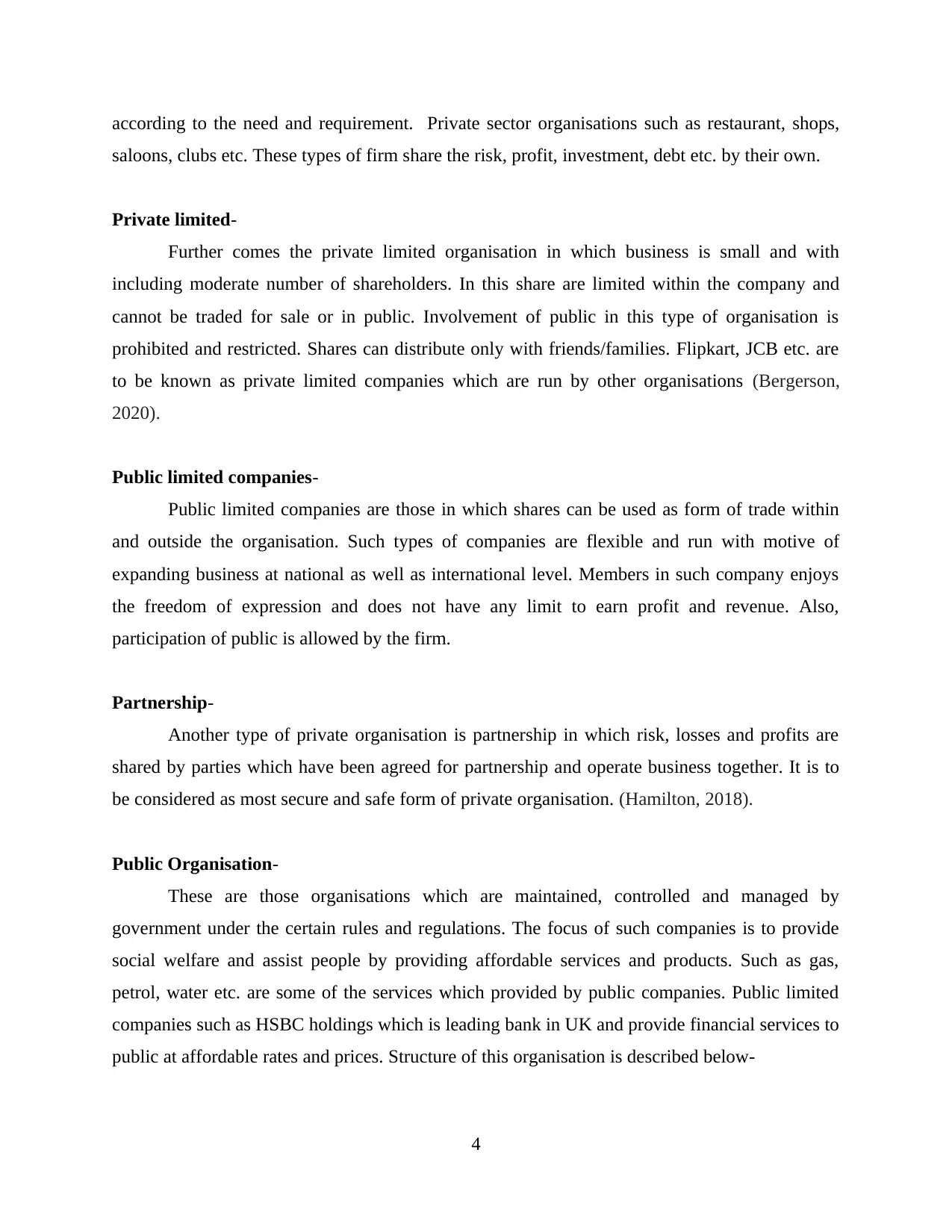
according to the need and requirement. Private sector organisations such as restaurant, shops,
saloons, clubs etc. These types of firm share the risk, profit, investment, debt etc. by their own.
Private limited-
Further comes the private limited organisation in which business is small and with
including moderate number of shareholders. In this share are limited within the company and
cannot be traded for sale or in public. Involvement of public in this type of organisation is
prohibited and restricted. Shares can distribute only with friends/families. Flipkart, JCB etc. are
to be known as private limited companies which are run by other organisations (Bergerson,
2020).
Public limited companies-
Public limited companies are those in which shares can be used as form of trade within
and outside the organisation. Such types of companies are flexible and run with motive of
expanding business at national as well as international level. Members in such company enjoys
the freedom of expression and does not have any limit to earn profit and revenue. Also,
participation of public is allowed by the firm.
Partnership-
Another type of private organisation is partnership in which risk, losses and profits are
shared by parties which have been agreed for partnership and operate business together. It is to
be considered as most secure and safe form of private organisation. (Hamilton, 2018).
Public Organisation-
These are those organisations which are maintained, controlled and managed by
government under the certain rules and regulations. The focus of such companies is to provide
social welfare and assist people by providing affordable services and products. Such as gas,
petrol, water etc. are some of the services which provided by public companies. Public limited
companies such as HSBC holdings which is leading bank in UK and provide financial services to
public at affordable rates and prices. Structure of this organisation is described below-
4
saloons, clubs etc. These types of firm share the risk, profit, investment, debt etc. by their own.
Private limited-
Further comes the private limited organisation in which business is small and with
including moderate number of shareholders. In this share are limited within the company and
cannot be traded for sale or in public. Involvement of public in this type of organisation is
prohibited and restricted. Shares can distribute only with friends/families. Flipkart, JCB etc. are
to be known as private limited companies which are run by other organisations (Bergerson,
2020).
Public limited companies-
Public limited companies are those in which shares can be used as form of trade within
and outside the organisation. Such types of companies are flexible and run with motive of
expanding business at national as well as international level. Members in such company enjoys
the freedom of expression and does not have any limit to earn profit and revenue. Also,
participation of public is allowed by the firm.
Partnership-
Another type of private organisation is partnership in which risk, losses and profits are
shared by parties which have been agreed for partnership and operate business together. It is to
be considered as most secure and safe form of private organisation. (Hamilton, 2018).
Public Organisation-
These are those organisations which are maintained, controlled and managed by
government under the certain rules and regulations. The focus of such companies is to provide
social welfare and assist people by providing affordable services and products. Such as gas,
petrol, water etc. are some of the services which provided by public companies. Public limited
companies such as HSBC holdings which is leading bank in UK and provide financial services to
public at affordable rates and prices. Structure of this organisation is described below-
4
Paraphrase This Document
Need a fresh take? Get an instant paraphrase of this document with our AI Paraphraser

Central government department- Such companies follows proper policies, rules and
regulations and operate their activities under the guidelines maintained by government.
Local Authorities- In this, local authorities are responsible for controlling and managing
entities activities.
Voluntary Organisation-
Another form of organisational structure is voluntary organisation in which business runs
with aiming to provide social welfare and assist to public. (Pinkovetskaia, 2018). These types of
entities require funds from financial institutions so that they can run their business activities at
appropriate manner. Such firm easily get funded by multinational companies and banks because
of their goodwill, creditability and social activities. Legal Structure of such organisation are
mentioned below-
Trust- A trust is formulated with motive of managing bodies, business purposes,
contracts etc. Trust includes trustees and group of people who are entitled and responsible
for managing different types of roles and duties.
Limited company- In such type of voluntary organisation, guarantee is limited, and
shares cannot be issued. Members in this firm can enjoy their rights which depicts the
flexibility amongst the management. (van Leeuwen, 2016).
Elaborate scope &size of organisations
Organisation focuses on growth and development of their business. Business can grow
only when it has aims objectives and mission which guides them in implementing strategies as
well as policies. So, scope and size are crucial in every business which are discussed below-
Private limited-
Private limited company focuses on earning profit and generating sales. These companies
achieve their goals by being dynamic and flexible in market. Acquisition of market and resources
are their priority. Private companies like TESCO is a leading retailers and distributors all over
the world and still expanding their business at international level. Mission- Main mission is to deliver good quality of products as well as services across
the globe. Vision- TESCO, vision is to be the global leader worldwide.
5
regulations and operate their activities under the guidelines maintained by government.
Local Authorities- In this, local authorities are responsible for controlling and managing
entities activities.
Voluntary Organisation-
Another form of organisational structure is voluntary organisation in which business runs
with aiming to provide social welfare and assist to public. (Pinkovetskaia, 2018). These types of
entities require funds from financial institutions so that they can run their business activities at
appropriate manner. Such firm easily get funded by multinational companies and banks because
of their goodwill, creditability and social activities. Legal Structure of such organisation are
mentioned below-
Trust- A trust is formulated with motive of managing bodies, business purposes,
contracts etc. Trust includes trustees and group of people who are entitled and responsible
for managing different types of roles and duties.
Limited company- In such type of voluntary organisation, guarantee is limited, and
shares cannot be issued. Members in this firm can enjoy their rights which depicts the
flexibility amongst the management. (van Leeuwen, 2016).
Elaborate scope &size of organisations
Organisation focuses on growth and development of their business. Business can grow
only when it has aims objectives and mission which guides them in implementing strategies as
well as policies. So, scope and size are crucial in every business which are discussed below-
Private limited-
Private limited company focuses on earning profit and generating sales. These companies
achieve their goals by being dynamic and flexible in market. Acquisition of market and resources
are their priority. Private companies like TESCO is a leading retailers and distributors all over
the world and still expanding their business at international level. Mission- Main mission is to deliver good quality of products as well as services across
the globe. Vision- TESCO, vision is to be the global leader worldwide.
5
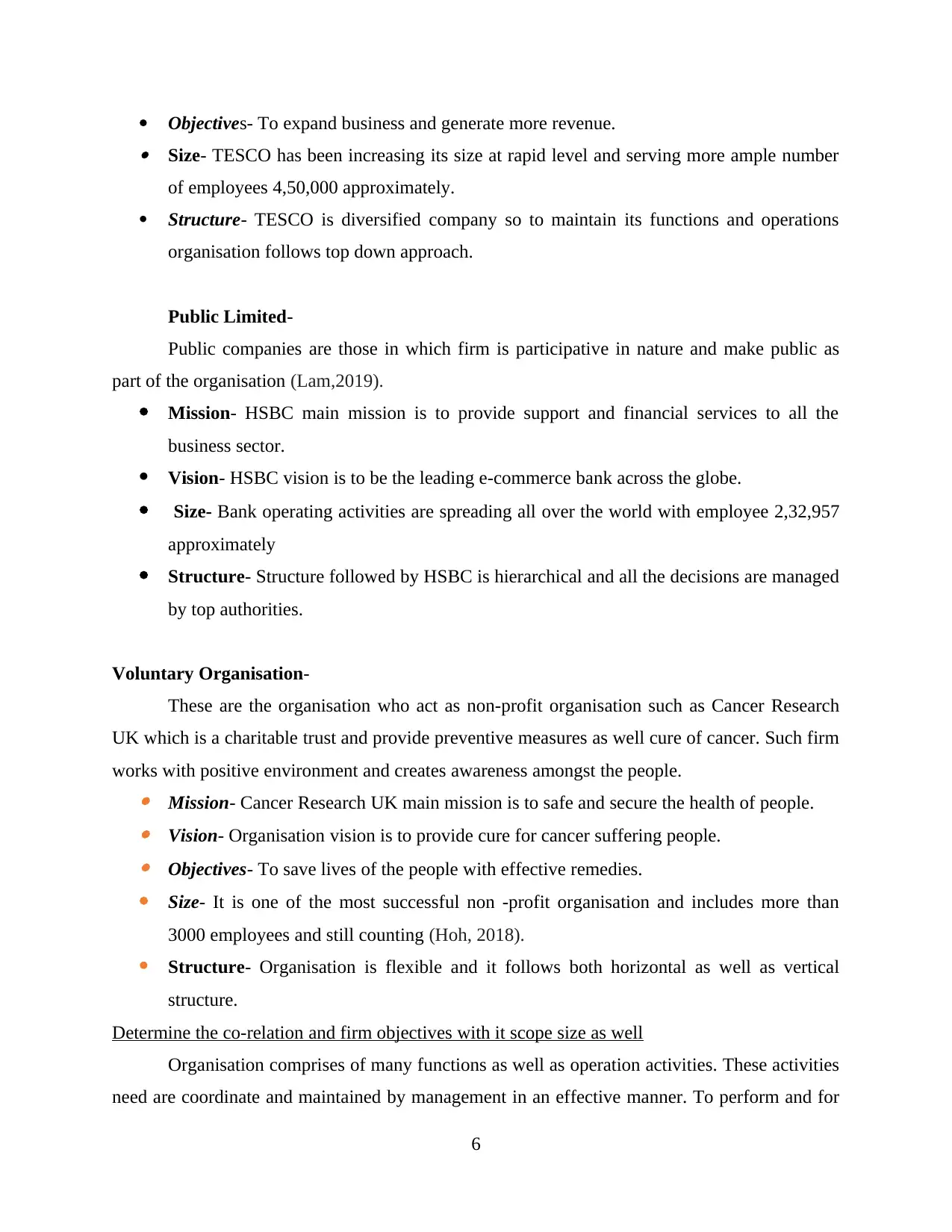
Objectives- To expand business and generate more revenue. Size- TESCO has been increasing its size at rapid level and serving more ample number
of employees 4,50,000 approximately.
Structure- TESCO is diversified company so to maintain its functions and operations
organisation follows top down approach.
Public Limited-
Public companies are those in which firm is participative in nature and make public as
part of the organisation (Lam,2019).
Mission- HSBC main mission is to provide support and financial services to all the
business sector.
Vision- HSBC vision is to be the leading e-commerce bank across the globe.
Size- Bank operating activities are spreading all over the world with employee 2,32,957
approximately
Structure- Structure followed by HSBC is hierarchical and all the decisions are managed
by top authorities.
Voluntary Organisation-
These are the organisation who act as non-profit organisation such as Cancer Research
UK which is a charitable trust and provide preventive measures as well cure of cancer. Such firm
works with positive environment and creates awareness amongst the people. Mission- Cancer Research UK main mission is to safe and secure the health of people. Vision- Organisation vision is to provide cure for cancer suffering people. Objectives- To save lives of the people with effective remedies.
Size- It is one of the most successful non -profit organisation and includes more than
3000 employees and still counting (Hoh, 2018).
Structure- Organisation is flexible and it follows both horizontal as well as vertical
structure.
Determine the co-relation and firm objectives with it scope size as well
Organisation comprises of many functions as well as operation activities. These activities
need are coordinate and maintained by management in an effective manner. To perform and for
6
of employees 4,50,000 approximately.
Structure- TESCO is diversified company so to maintain its functions and operations
organisation follows top down approach.
Public Limited-
Public companies are those in which firm is participative in nature and make public as
part of the organisation (Lam,2019).
Mission- HSBC main mission is to provide support and financial services to all the
business sector.
Vision- HSBC vision is to be the leading e-commerce bank across the globe.
Size- Bank operating activities are spreading all over the world with employee 2,32,957
approximately
Structure- Structure followed by HSBC is hierarchical and all the decisions are managed
by top authorities.
Voluntary Organisation-
These are the organisation who act as non-profit organisation such as Cancer Research
UK which is a charitable trust and provide preventive measures as well cure of cancer. Such firm
works with positive environment and creates awareness amongst the people. Mission- Cancer Research UK main mission is to safe and secure the health of people. Vision- Organisation vision is to provide cure for cancer suffering people. Objectives- To save lives of the people with effective remedies.
Size- It is one of the most successful non -profit organisation and includes more than
3000 employees and still counting (Hoh, 2018).
Structure- Organisation is flexible and it follows both horizontal as well as vertical
structure.
Determine the co-relation and firm objectives with it scope size as well
Organisation comprises of many functions as well as operation activities. These activities
need are coordinate and maintained by management in an effective manner. To perform and for
6
⊘ This is a preview!⊘
Do you want full access?
Subscribe today to unlock all pages.

Trusted by 1+ million students worldwide
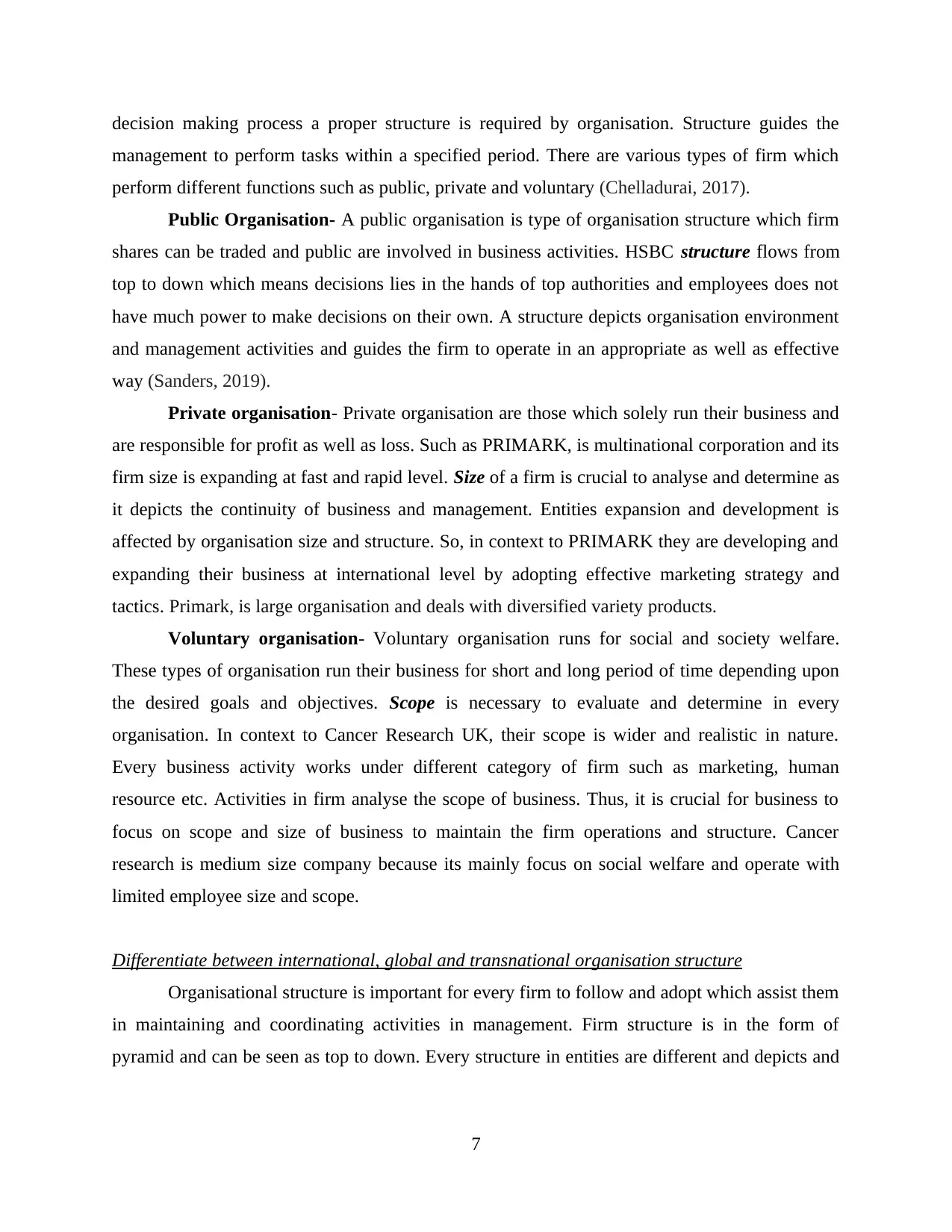
decision making process a proper structure is required by organisation. Structure guides the
management to perform tasks within a specified period. There are various types of firm which
perform different functions such as public, private and voluntary (Chelladurai, 2017).
Public Organisation- A public organisation is type of organisation structure which firm
shares can be traded and public are involved in business activities. HSBC structure flows from
top to down which means decisions lies in the hands of top authorities and employees does not
have much power to make decisions on their own. A structure depicts organisation environment
and management activities and guides the firm to operate in an appropriate as well as effective
way (Sanders, 2019).
Private organisation- Private organisation are those which solely run their business and
are responsible for profit as well as loss. Such as PRIMARK, is multinational corporation and its
firm size is expanding at fast and rapid level. Size of a firm is crucial to analyse and determine as
it depicts the continuity of business and management. Entities expansion and development is
affected by organisation size and structure. So, in context to PRIMARK they are developing and
expanding their business at international level by adopting effective marketing strategy and
tactics. Primark, is large organisation and deals with diversified variety products.
Voluntary organisation- Voluntary organisation runs for social and society welfare.
These types of organisation run their business for short and long period of time depending upon
the desired goals and objectives. Scope is necessary to evaluate and determine in every
organisation. In context to Cancer Research UK, their scope is wider and realistic in nature.
Every business activity works under different category of firm such as marketing, human
resource etc. Activities in firm analyse the scope of business. Thus, it is crucial for business to
focus on scope and size of business to maintain the firm operations and structure. Cancer
research is medium size company because its mainly focus on social welfare and operate with
limited employee size and scope.
Differentiate between international, global and transnational organisation structure
Organisational structure is important for every firm to follow and adopt which assist them
in maintaining and coordinating activities in management. Firm structure is in the form of
pyramid and can be seen as top to down. Every structure in entities are different and depicts and
7
management to perform tasks within a specified period. There are various types of firm which
perform different functions such as public, private and voluntary (Chelladurai, 2017).
Public Organisation- A public organisation is type of organisation structure which firm
shares can be traded and public are involved in business activities. HSBC structure flows from
top to down which means decisions lies in the hands of top authorities and employees does not
have much power to make decisions on their own. A structure depicts organisation environment
and management activities and guides the firm to operate in an appropriate as well as effective
way (Sanders, 2019).
Private organisation- Private organisation are those which solely run their business and
are responsible for profit as well as loss. Such as PRIMARK, is multinational corporation and its
firm size is expanding at fast and rapid level. Size of a firm is crucial to analyse and determine as
it depicts the continuity of business and management. Entities expansion and development is
affected by organisation size and structure. So, in context to PRIMARK they are developing and
expanding their business at international level by adopting effective marketing strategy and
tactics. Primark, is large organisation and deals with diversified variety products.
Voluntary organisation- Voluntary organisation runs for social and society welfare.
These types of organisation run their business for short and long period of time depending upon
the desired goals and objectives. Scope is necessary to evaluate and determine in every
organisation. In context to Cancer Research UK, their scope is wider and realistic in nature.
Every business activity works under different category of firm such as marketing, human
resource etc. Activities in firm analyse the scope of business. Thus, it is crucial for business to
focus on scope and size of business to maintain the firm operations and structure. Cancer
research is medium size company because its mainly focus on social welfare and operate with
limited employee size and scope.
Differentiate between international, global and transnational organisation structure
Organisational structure is important for every firm to follow and adopt which assist them
in maintaining and coordinating activities in management. Firm structure is in the form of
pyramid and can be seen as top to down. Every structure in entities are different and depicts and
7
Paraphrase This Document
Need a fresh take? Get an instant paraphrase of this document with our AI Paraphraser

perform according to process and procedure. Different types of structures are followed by
enterprises
Complexities of different form of structure is mentioned below-
Transnational Companies- These forms of organisational structure act as hybrid firm
because in this business is divided and well organised into different regions, locations,
demographic variables etc. Transnational companies mostly consolidate activities and
perform their functions as well as operations with different foreign markets and
decision-making process is participative in this type of structure.
International organisation structure- Another form of organisational structure is
international companies’ structures which act as distributors and retailers in their home
country. Such companies do not invest outside their region country and operate their
operation activities within the limited area (Bergeson, 2020).
Global companies- These are those companies which operate their activities and
functions in at global level and market their product and services with help of brand
name and value. In such type of organisation, mostly one head of all the department is
responsible for business strategies and growth.
TASK 2
Describe various types of functions in relevance with mission and objectives of firm
A function means activities which are to be carried out by organisation and department unit.
Functions are of various types such R&D, finance, human resource etc. Each function is
important and contributes equal effort in business expansion and development. It depends upon
firm focus on which types of functions. Different types of functions are mentioned below and the
relationship between the functions.
Human Resource and Marketing-
The most important asset of the firm is Human resource. They are responsible for overall
growth and development of business. HR in organisation perform various activities such hiring
and recruiting right people, maintaining management policies and procedures and examining
optimum use of resources (Hamilton, 2018).
8
enterprises
Complexities of different form of structure is mentioned below-
Transnational Companies- These forms of organisational structure act as hybrid firm
because in this business is divided and well organised into different regions, locations,
demographic variables etc. Transnational companies mostly consolidate activities and
perform their functions as well as operations with different foreign markets and
decision-making process is participative in this type of structure.
International organisation structure- Another form of organisational structure is
international companies’ structures which act as distributors and retailers in their home
country. Such companies do not invest outside their region country and operate their
operation activities within the limited area (Bergeson, 2020).
Global companies- These are those companies which operate their activities and
functions in at global level and market their product and services with help of brand
name and value. In such type of organisation, mostly one head of all the department is
responsible for business strategies and growth.
TASK 2
Describe various types of functions in relevance with mission and objectives of firm
A function means activities which are to be carried out by organisation and department unit.
Functions are of various types such R&D, finance, human resource etc. Each function is
important and contributes equal effort in business expansion and development. It depends upon
firm focus on which types of functions. Different types of functions are mentioned below and the
relationship between the functions.
Human Resource and Marketing-
The most important asset of the firm is Human resource. They are responsible for overall
growth and development of business. HR in organisation perform various activities such hiring
and recruiting right people, maintaining management policies and procedures and examining
optimum use of resources (Hamilton, 2018).
8
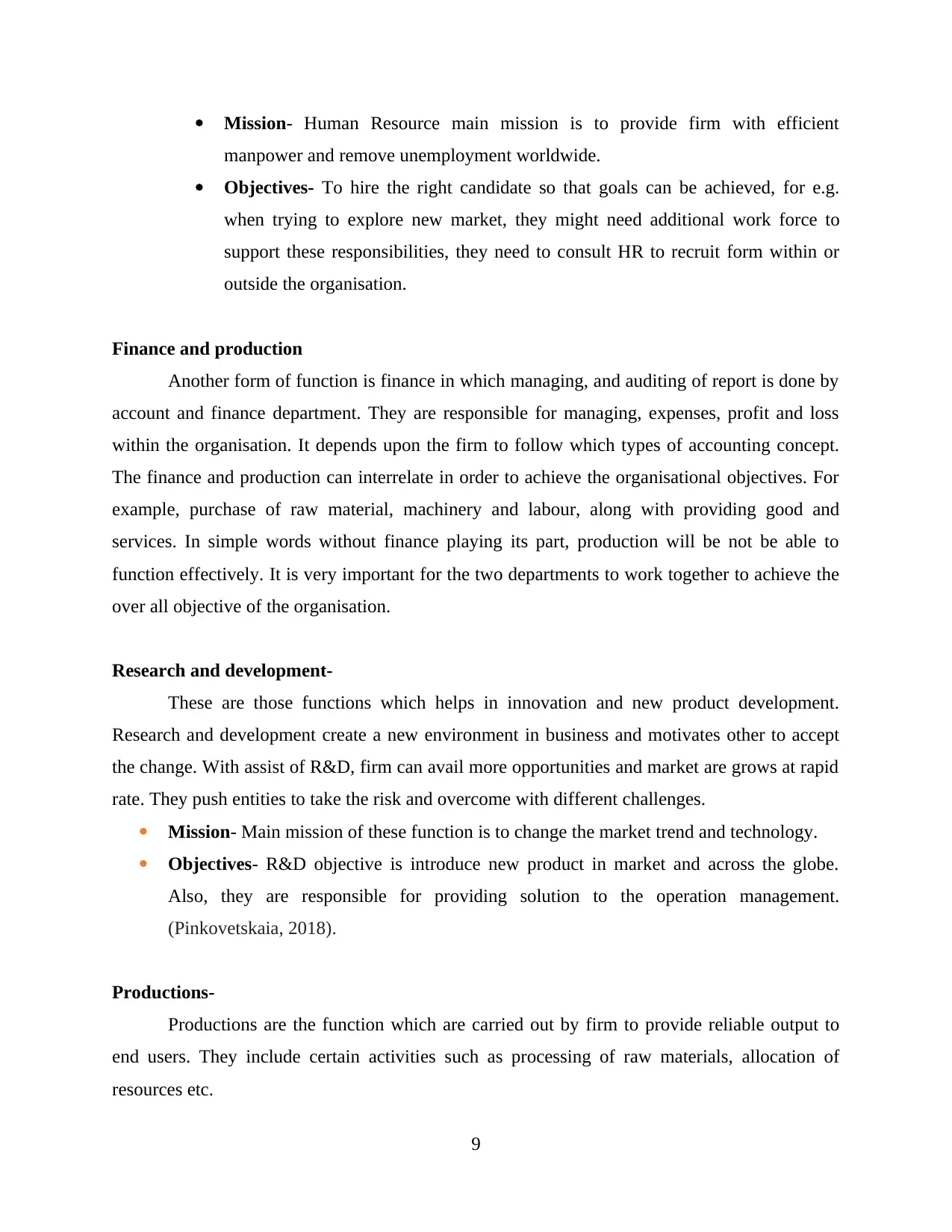
Mission- Human Resource main mission is to provide firm with efficient
manpower and remove unemployment worldwide.
Objectives- To hire the right candidate so that goals can be achieved, for e.g.
when trying to explore new market, they might need additional work force to
support these responsibilities, they need to consult HR to recruit form within or
outside the organisation.
Finance and production
Another form of function is finance in which managing, and auditing of report is done by
account and finance department. They are responsible for managing, expenses, profit and loss
within the organisation. It depends upon the firm to follow which types of accounting concept.
The finance and production can interrelate in order to achieve the organisational objectives. For
example, purchase of raw material, machinery and labour, along with providing good and
services. In simple words without finance playing its part, production will be not be able to
function effectively. It is very important for the two departments to work together to achieve the
over all objective of the organisation.
Research and development-
These are those functions which helps in innovation and new product development.
Research and development create a new environment in business and motivates other to accept
the change. With assist of R&D, firm can avail more opportunities and market are grows at rapid
rate. They push entities to take the risk and overcome with different challenges.
Mission- Main mission of these function is to change the market trend and technology.
Objectives- R&D objective is introduce new product in market and across the globe.
Also, they are responsible for providing solution to the operation management.
(Pinkovetskaia, 2018).
Productions-
Productions are the function which are carried out by firm to provide reliable output to
end users. They include certain activities such as processing of raw materials, allocation of
resources etc.
9
manpower and remove unemployment worldwide.
Objectives- To hire the right candidate so that goals can be achieved, for e.g.
when trying to explore new market, they might need additional work force to
support these responsibilities, they need to consult HR to recruit form within or
outside the organisation.
Finance and production
Another form of function is finance in which managing, and auditing of report is done by
account and finance department. They are responsible for managing, expenses, profit and loss
within the organisation. It depends upon the firm to follow which types of accounting concept.
The finance and production can interrelate in order to achieve the organisational objectives. For
example, purchase of raw material, machinery and labour, along with providing good and
services. In simple words without finance playing its part, production will be not be able to
function effectively. It is very important for the two departments to work together to achieve the
over all objective of the organisation.
Research and development-
These are those functions which helps in innovation and new product development.
Research and development create a new environment in business and motivates other to accept
the change. With assist of R&D, firm can avail more opportunities and market are grows at rapid
rate. They push entities to take the risk and overcome with different challenges.
Mission- Main mission of these function is to change the market trend and technology.
Objectives- R&D objective is introduce new product in market and across the globe.
Also, they are responsible for providing solution to the operation management.
(Pinkovetskaia, 2018).
Productions-
Productions are the function which are carried out by firm to provide reliable output to
end users. They include certain activities such as processing of raw materials, allocation of
resources etc.
9
⊘ This is a preview!⊘
Do you want full access?
Subscribe today to unlock all pages.

Trusted by 1+ million students worldwide

Mission- Main mission of production is to provide more profit to business.
Objectives- Production main objective is to deliver efficient input and output to
organisation.
Administrative (Management)-
These are those types of functions in which managing as well as handling of activities are
maintained by management. They coordinate all the paperwork of organisation.
Mission- Their main mission is to maintain and support services within the organisation.
Objectives- Objectives are important to achieve in business. Thus, main objective of
administrative department is to manage and create a positive relationship and workforce.
Thus, every function and structure of organisation affect the business activities at broad level.
So, it is crucial for firm to considered and operate these functions in appropriate manner.
Because organisation and function both are dependent on each other (van Leeuwen, 2016).
TASK 3
Comparison between micro, small, medium size and large enterprises
Basis Micro
Enterprises
Small Enterprise Medium
Enterprise
Large
enterprise
Market share
In this, size of
market share is
small and does not
grow.
Market share of
small enterprise is
bigger than micro
and have wider
opportunities.
(Cagle, 2020).
Medium
enterprises
market share is
depending upon
capital of firm
and percentage
of market is
fluctuating.
In this, market
share of large
enterprise is
more than
small and
micro
enterprises
(Zayed, 2019).
In micro, ratio of Small enterprises Profit sharing is In this, profit
10
Objectives- Production main objective is to deliver efficient input and output to
organisation.
Administrative (Management)-
These are those types of functions in which managing as well as handling of activities are
maintained by management. They coordinate all the paperwork of organisation.
Mission- Their main mission is to maintain and support services within the organisation.
Objectives- Objectives are important to achieve in business. Thus, main objective of
administrative department is to manage and create a positive relationship and workforce.
Thus, every function and structure of organisation affect the business activities at broad level.
So, it is crucial for firm to considered and operate these functions in appropriate manner.
Because organisation and function both are dependent on each other (van Leeuwen, 2016).
TASK 3
Comparison between micro, small, medium size and large enterprises
Basis Micro
Enterprises
Small Enterprise Medium
Enterprise
Large
enterprise
Market share
In this, size of
market share is
small and does not
grow.
Market share of
small enterprise is
bigger than micro
and have wider
opportunities.
(Cagle, 2020).
Medium
enterprises
market share is
depending upon
capital of firm
and percentage
of market is
fluctuating.
In this, market
share of large
enterprise is
more than
small and
micro
enterprises
(Zayed, 2019).
In micro, ratio of Small enterprises Profit sharing is In this, profit
10
Paraphrase This Document
Need a fresh take? Get an instant paraphrase of this document with our AI Paraphraser
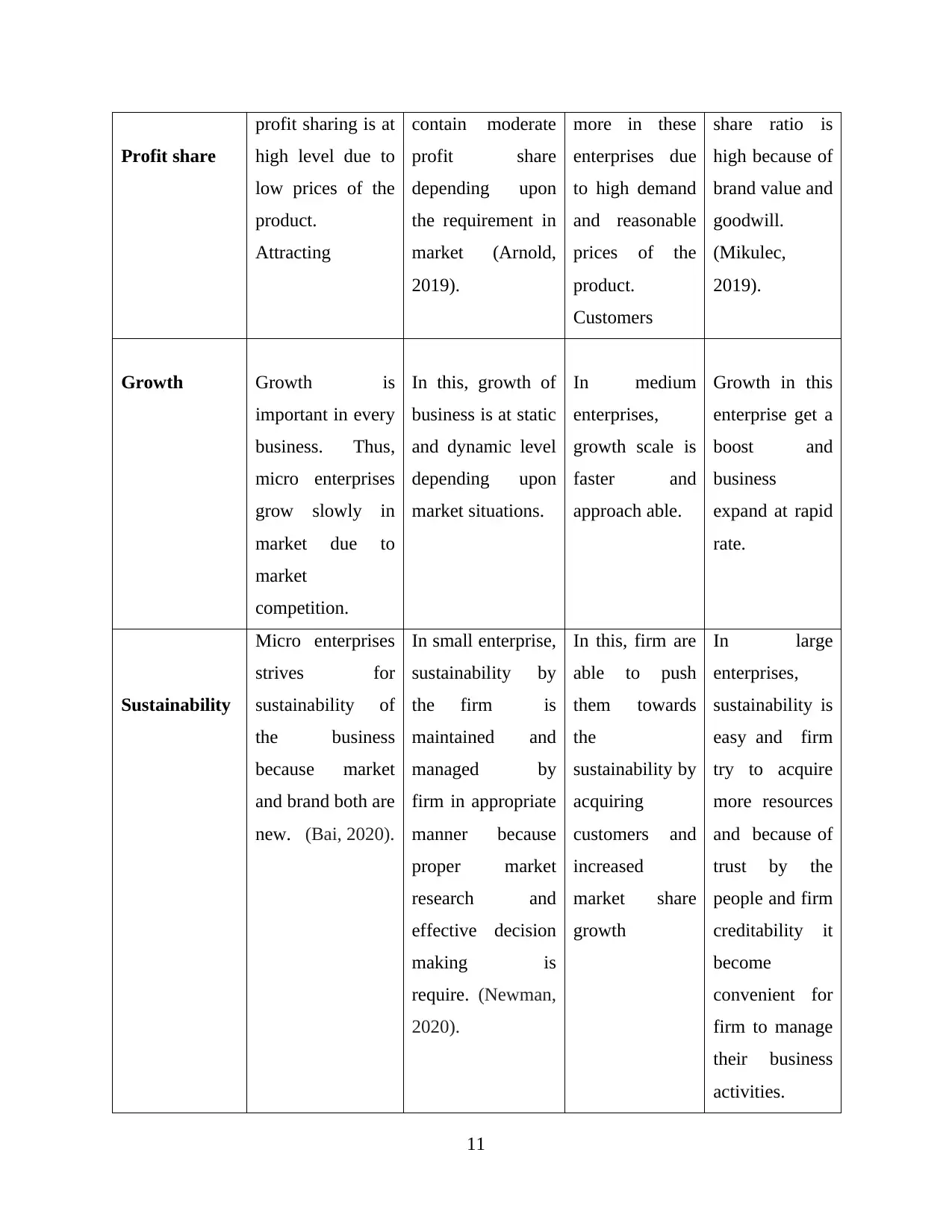
Profit share
profit sharing is at
high level due to
low prices of the
product.
Attracting
contain moderate
profit share
depending upon
the requirement in
market (Arnold,
2019).
more in these
enterprises due
to high demand
and reasonable
prices of the
product.
Customers
share ratio is
high because of
brand value and
goodwill.
(Mikulec,
2019).
Growth Growth is
important in every
business. Thus,
micro enterprises
grow slowly in
market due to
market
competition.
In this, growth of
business is at static
and dynamic level
depending upon
market situations.
In medium
enterprises,
growth scale is
faster and
approach able.
Growth in this
enterprise get a
boost and
business
expand at rapid
rate.
Sustainability
Micro enterprises
strives for
sustainability of
the business
because market
and brand both are
new. (Bai, 2020).
In small enterprise,
sustainability by
the firm is
maintained and
managed by
firm in appropriate
manner because
proper market
research and
effective decision
making is
require. (Newman,
2020).
In this, firm are
able to push
them towards
the
sustainability by
acquiring
customers and
increased
market share
growth
In large
enterprises,
sustainability is
easy and firm
try to acquire
more resources
and because of
trust by the
people and firm
creditability it
become
convenient for
firm to manage
their business
activities.
11
profit sharing is at
high level due to
low prices of the
product.
Attracting
contain moderate
profit share
depending upon
the requirement in
market (Arnold,
2019).
more in these
enterprises due
to high demand
and reasonable
prices of the
product.
Customers
share ratio is
high because of
brand value and
goodwill.
(Mikulec,
2019).
Growth Growth is
important in every
business. Thus,
micro enterprises
grow slowly in
market due to
market
competition.
In this, growth of
business is at static
and dynamic level
depending upon
market situations.
In medium
enterprises,
growth scale is
faster and
approach able.
Growth in this
enterprise get a
boost and
business
expand at rapid
rate.
Sustainability
Micro enterprises
strives for
sustainability of
the business
because market
and brand both are
new. (Bai, 2020).
In small enterprise,
sustainability by
the firm is
maintained and
managed by
firm in appropriate
manner because
proper market
research and
effective decision
making is
require. (Newman,
2020).
In this, firm are
able to push
them towards
the
sustainability by
acquiring
customers and
increased
market share
growth
In large
enterprises,
sustainability is
easy and firm
try to acquire
more resources
and because of
trust by the
people and firm
creditability it
become
convenient for
firm to manage
their business
activities.
11

After a brief analysis of small, micro, medium and large enterprises it can be stated that
every firm is heterogeneous and perform various types of functions as well as operations.
Business expansion of entities depends upon several basis which has been shown in the above
table. Hence, firm should focus on all the activities and situations of market which assist
organisation to overcome the challenges and threats.
Examining positive and negative impact of macro environment in business
Macro environment are important to analyse and considered in organisation. Macro
environment affect the business at broad level. Macro environment affect the business in
different ways which is stated as follows by using PESTEL analysis.
PESTLE Analysis-
It is marketing tool used by firm to determine the external factors which the business
activities and operation at broad level. This is a supportive tool for business which evaluate
market situation and activities-
POLITICAL-
Political factors are those which includes labour law, tax policy etc. which affects the business
operation and functions. These factors are uncontrollable by firm because they occur outside the
organisation. Primark is also affected by political factor because tax policy has deep impact on it
sales revenue.
ECONOMICAL-
These are those factors which comprises of inflation and deflation rate, trade policies etc.
They affect the business growth and slow down the progress and development of entity. These
factors are unpredictable in nature. In context to Primark, they maintain analysis of market
research and which helps them to tackle with economic elements.
SOCIAL -
Another factor affecting business is social factor which comprises of standard of living,
culture, religion etc. Besides profit earning motive these are also crucial for every business to
analyse and considered. Development and growth of business activities depends upon these
12
every firm is heterogeneous and perform various types of functions as well as operations.
Business expansion of entities depends upon several basis which has been shown in the above
table. Hence, firm should focus on all the activities and situations of market which assist
organisation to overcome the challenges and threats.
Examining positive and negative impact of macro environment in business
Macro environment are important to analyse and considered in organisation. Macro
environment affect the business at broad level. Macro environment affect the business in
different ways which is stated as follows by using PESTEL analysis.
PESTLE Analysis-
It is marketing tool used by firm to determine the external factors which the business
activities and operation at broad level. This is a supportive tool for business which evaluate
market situation and activities-
POLITICAL-
Political factors are those which includes labour law, tax policy etc. which affects the business
operation and functions. These factors are uncontrollable by firm because they occur outside the
organisation. Primark is also affected by political factor because tax policy has deep impact on it
sales revenue.
ECONOMICAL-
These are those factors which comprises of inflation and deflation rate, trade policies etc.
They affect the business growth and slow down the progress and development of entity. These
factors are unpredictable in nature. In context to Primark, they maintain analysis of market
research and which helps them to tackle with economic elements.
SOCIAL -
Another factor affecting business is social factor which comprises of standard of living,
culture, religion etc. Besides profit earning motive these are also crucial for every business to
analyse and considered. Development and growth of business activities depends upon these
12
⊘ This is a preview!⊘
Do you want full access?
Subscribe today to unlock all pages.

Trusted by 1+ million students worldwide
1 out of 17
Related Documents
Your All-in-One AI-Powered Toolkit for Academic Success.
+13062052269
info@desklib.com
Available 24*7 on WhatsApp / Email
![[object Object]](/_next/static/media/star-bottom.7253800d.svg)
Unlock your academic potential
Copyright © 2020–2025 A2Z Services. All Rights Reserved. Developed and managed by ZUCOL.





